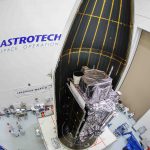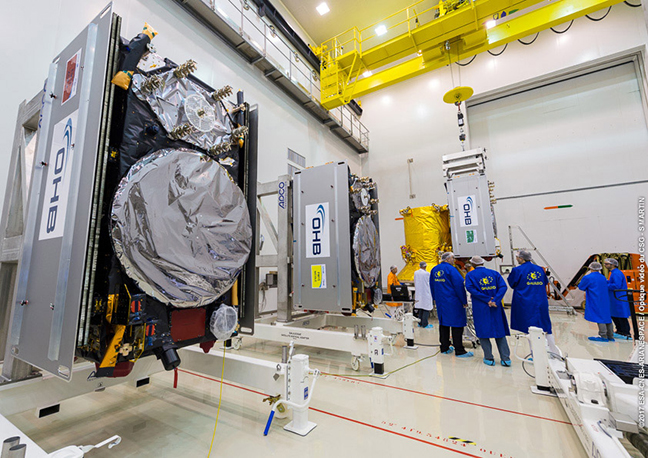Viewers watching Arianespace’s live video webcast Tuesday witnessed a successful launch that began at approximately 1820 GMT (1:20 p.m. EST).
Prior to liftoff, four European navigation satellites were fastened on top of an Ariane 5 rocket awaiting liftoff from Kourou, French Guiana, Tuesday to propel the Galileo navigation network closer to global service. The Ariane 5’s upper stage was slated to deliver the spacecraft to a circular orbit more than 14,000 miles above Earth around four hours after launch.
About 8 minutes in, viewers saw the rocket get in range of a communications station on a hip in the Atlantic Ocean. At that moment, the launcher was about to shut down its first stage and ignite its cryogenic upper stage. At plus+3 minutes, 30 seconds, separation of the rocket’s nose cone had been confirmed.
The solid rocket boosters were jettisoned from the Ariane 5 rocket’s core stage after consuming approximately 480 metric tons of propellant. The liquid-fueled Vulcain 2 main engine continued, at that time, to fire to propel the vehicle and its satellite payload to space.
Twenty minutes after the launch Arianespace reported no problems and the Ariane 5 rocket had reached a nominal transfer orbit to begin the three-hour coast before the Aestus engine was to be reignited.
A European Ariane 5 rocket followed dual rail tracks across the Guiana Space Center in South America on Monday on the way to its launch complex, a day before today’s blastoff with four satellites to expand the Galileo navigation network.
Last week Inside GNSS reported the mission payload of four Galileo navigation satellites was now ready to join up with its Ariane 5 launcher, in preparation for today’s big day, Arianespace’s year-ending flight from the Spaceport in French Guiana.
The spacecraft were fueled and installed on their multi-payload dispenser system, clearing the way for transfer from the Spaceport’s S3B clean room to Ariane 5’s Final Assembly Building.
Designated Flight VA240, the mission marks Arianespace’s second use of an Ariane 5 ES version to loft spacecraft for Europe’s Galileo global navigation system – following the first four-passenger launch in November 2016 on the heavy-lift launcher.
This came after seven previous missions using the medium-lift Soyuz, which carried a pair of operational satellites each.
This launch will bring the total Galileo constellation to 22, boosting the global availability of navigation signals. Galileo began Initial Services just under a year ago, the first step before full operations, on December 15, 2016.






